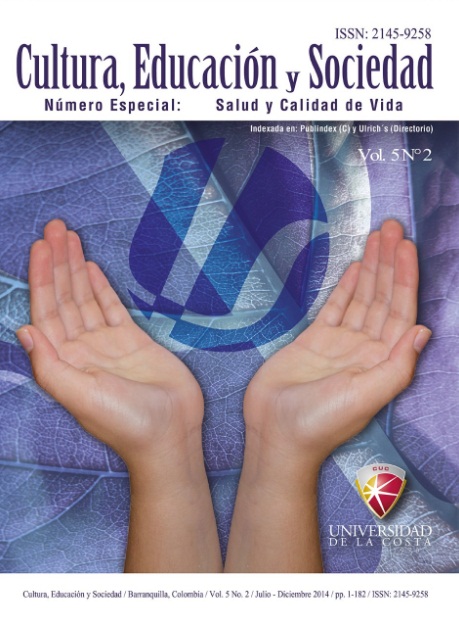The bipolarity as a mood disorder in the XXI century: Seen from a neurological perspective
Keywords:
Bipolar; moods; depression; neuroscienceAbstract
This study aimed to make a presentation type descripti-ve - documentary on bipolar disorder as a mood disorder in the xxi century, performing the same from a neuro-logical perspective; this derived from the theory that be-yond the large type of mood disorder in the world, which itself can say is that we try here a collection of disorders diseases which are not unitary, but complex syndromes with different etiologies, courses and therapeutic res-ponses, which are characterized by as a fundamental symptom altered mood or affection, which usually binds a change in the general level of activity. Thus, disorders of spirits are nothing but disturbance or disruption the mood of the individual, which vary in intensity and quality. Thus, the essential feature of the disorder this category is that all reflect an imbalance the emotional reaction or state of mind that does not due to any other physical or mental disorder. These are also known as affective disorders. Therefore, it follows that the mood disorder during senescence accompanied by nosologica complexities, phenomenological, diagnostic and thera-peutic requiring special knowledge. They are frequent presentations little visual clinical and pseudo-hidden de-pression and dementia that can confuse the diagnosis of any disease. it is essential to be deeply familiar with all these aspects to identify and adequately treat geriatric patients.
Downloads
References
Alonso-Fernández F. (1998).Cuestionario Estructural Tetradimensional para la Depresión (CET-DE). 4a Edición. Editorial Publicaciones de Psicología Aplicada. Madrid, España. American Psychiatric Associationn (2002). “Guía clínica para el tratamiento del trastorno bipolar”Segunda edición. Ars Medica, Psiquiatría editores. Barcelona.
Asociación Psiquiátrica Americana DSM-iV-TR (2003). Manual Diagnóstico y estadístico de los trastornos mentales, Ediciones Masson, Barcelona.
Asociación Americana Sobre Retraso Mental AAMR (2006). Retraso mental. Definición, clasificación y sistemas de apoyo, traducción de Miguel Ángel Verdugo y Cristina Jenaro, 10ª ed., 1ª reimpresión, Alianza, Madrid.
CiE 10: Trastornos mentales y del comportamiento. (2004). Descripciones clínicas y pautas para el diagnóstico, Organización Mundial de la Salud, Meditor, Madrid.
DSM-iV-TR: Manual diagnóstico y estadístico de los trastornos mentales. (2005). Texto Revisado (PiCHOT, P. -coordinador general de las ediciones española, francesa e italiana-; LÓPEZ-iBOR ALiÑO, J.J. -director de la edición española; Valdés Miyar, M.-coordinador de la edición españo-la-), 1ª ed., 3ª reimpresión, Masson, Barcelona.
García Andrade, J. (2002). Psiquiatría criminal y forense, 2ª ed., Centro de Estudios Ramón Areces, Madrid.
Kaplan, H.; Sadock, B. & Grebb, J. (1997). “Sinopsis de Psiquiatría”. Baltimore, Maryland, William Wilkins; Argentina, Editorial Panamericana.
Suárez Richards M. (1995). “Introducción a la psiquiatría”. Editorial Salerno. Argentina.
Stahl S. M. (2002). Essential Psychopharmacology, Neuroscientific Basis and Practical Applications. Second Edition, Cambridge.
Vasquez, G. (2007). Trastornos del estado de ánimo. Depresión y bipolaridad. Editorial Polemos. Primera Edición.
Vieta, E. (2001). Trastornos Bipolares. Avances clínicos y terapéuticos, Editorial Panamericana. Madrid, España.
Downloads
Published
How to Cite
Issue
Section
License
Copyright (c) 2014 CULTURA EDUCACIÓN Y SOCIEDAD

This work is licensed under a Creative Commons Attribution-NonCommercial-NoDerivatives 4.0 International License.
![]()
Creative Commons 2020 CULTURA EDUCACIÓN Y SOCIEDAD
This article is under international license Creative Commons Reconocimiento-NoComercial-SinObrasDerivadas 4.0.
The published articles are the sole responsibility of their authors and do not necessarily reflect the opinions of the editorial committee.
CULTURA EDUCACIÓN Y SOCIEDAD respects the moral rights of its authors, who assign to the editorial committee the patrimonial rights of the published material. In turn, the authors inform that this work is unpublished and has not been previously published.
All articles are under a:
Licencia Creative Commons Atribución-NoComercial-SinDerivadas 4.0 Internacional.
![]()


 English
English
 Español (España)
Español (España)




_12.53_.27_p_. m_._3.png)





_12.57_.35_p_. m_._3.png)
_12.50_.37_p_. m_._3.png)



